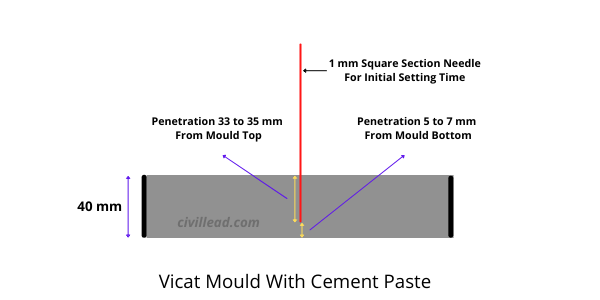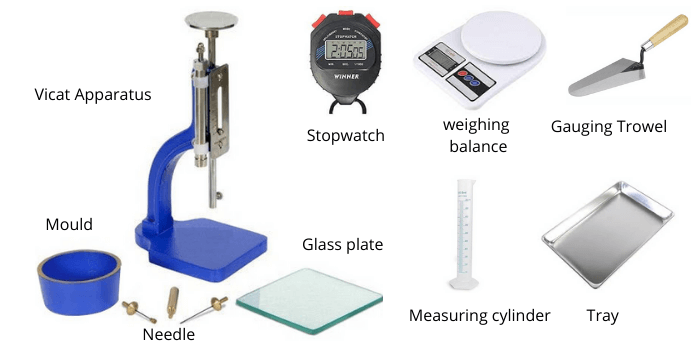Table of Contents
Initial And Final Setting Time of Cement
When water is mixed in cement, the hydration process starts, and it forms a paste moulded in any desired shape because of its plasticity.
The cement continues to react with water, and with time it loses its plasticity and hardens. This process is termed as setting time of cement.
Initial setting time tells us how much time cement remains in its plastic state. The final setting time helps to know the time after which cement hardened sufficiently.
Initial Setting Time
The initial setting time is the interval in the middle of adding water to cement and when the needle ceases to penetrate completely and remains 5 mm above the mould bottom.
The initial setting time of cement is the time interval when water is mixed into cement until the needle of 1 mm square section can penetrate the cement paste, placed in the Vicat’s mould 33 mm to 35 mm from the mould top.

When cement begins hardening and entirely loses its plasticity is termed as the initial setting time of the cement.
Final Setting Time
Final Setting time is the time taken during the operation as the water is mixed into the cement and when paste loses its plasticity completely.
The final setting is when water is mixed into cement until a 1 mm square section needle can create an impression (0.5mm) on the cement paste, but an attachment cannot do the same.
When cement totally loses its moldability or plasticity and achieving significant hardness is the final setting time of the cement.
Importance of Initial And Final Setting Time
After mixing cement with water, placing the cement paste in a position requires time. Initial setting time plays an essential role in the strength of cement or concrete.
In the case of ordinary Portland cement, the cement paste or concrete must be placed before crossing the initial setting time. i.e.,30 minutes and should not be disturbed until it meets the Final setting time, i.e., 600 minutes.
- The cement should not be set too fast and not be too slow. If it set rapidly, it doesn’t offer sufficient time for transportation and placing of the concrete. While if it is set too late, it can slow down the work and might be postponed due to less strength at the desired time.
- The setting of cement should not be compared with hardening. It is a mechanical strength gained after a specific time interval to resist the penetration of a special attachment dropped into it.
- Initial setting time is essential to transport, placing and compaction of concrete.
- Initial setting time is necessary to delay the hydration process and hardening.
- Final setting time helps to remove shuttering or formwork safely.
- Cement completed its chemical reaction with water till the final setting time.
Factors Affecting The Initial And Final Setting Time
Following factors affect the initial and final setting time of cement:-
- The fineness of cement,
- Presence of salts in the sand,
- Climate conditions.
For instance, cement demands a temperature of 27°c to achieve hydration. During winters, the temperature is low, stopping the hydration and taking longer to set harden.
Procedure to Calculate Setting Time of Cement
According to IS:4031 (Part 5) – 1988. Initial and final setting time for cement is determined with the help of VICAT apparatus following to IS:5513 – 1976,
Apparatus

- Vicat Apparatus
- Weighing Balance
- Measuring Cylinder
- Glass plate
- Trowel
- Enamel Tray
- Stopwatch
Test Procedure
- Before starting the test procedure, the standard or normal consistency test of cement should be performed to know the quantity of water needed to prepare the cement paste of standard consistency(p).
- Take sample of cement of about 400 grams on a tray.
- Now mix water about 0.85P into the cement and start the stopwatch when water is added. Record this time as T1. The gauging time must be within 3 to 5 minutes.
- Now fill the Vicat mould with paste of cement on the non-porous glass plate. If there is any excess cement paste on the mould, take it off through the trowel and level it.
Note – Quantity of water 0.85P means 85% of normal consistency of cement. If the consistency of cement is 30% then water quantity is = 85% × standard consistency × Weight of cement sample = 85/100 × 30/100 × 400 = 102 grams.
For Initial Setting Time

- Now place the test block enclosed in the mould and rest on the non-porous glass plate under the rod holding the needle.
- Now smoothly lower the needle until it touches the test block surface and releases it fast, penetrating the test block.
- At starting, the needle sinks into the test block completely. Repeat this process after every 5 -10 minutes until the needle penetrates the test block about 5 to 7 mm from the mould bottom or 33 to 35 mm from the top. Record this time as T2.
For Final Setting Time

- For determining the final setting time, change the Vicat apparatus needle to one with an annular attachment.
- We consider the cement as finally set when the paste has attained such hardness that When we gently apply the needle to the test block surface, the needle creates an impression there, while the attachment fails to do the same. Record this time as T3.
CalCulation
Initial setting Time = T2 – T1
Final Setting Time = T3 – T1
Where,
T1 =Time when water is mixed into cement
T2 =Time when needle unable to penetrate 33 mm to 35 mm from the mould top or 5 to 7 mm from mould bottom.
T3 =Time when the needle creates an impression while the attachment cannot do the same.
Standard Setting Time for Various Cement
Different types of cement are used in construction work, and the type of cement and admixture used during their manufacturing initial and final setting time vary from cement to cement. As per the IS: code standard-setting time for various types of cement is as follows.
| Type of Cement | IS Code | Initial Setting Time (Min) | Final Setting Time (Max) |
|---|---|---|---|
| Ordinary Portland Cement (OPC-33) | IS: 269 | 30 | 600 |
| OPC – 43 | IS: 8112 | 30 | 600 |
| OPC – 53 | IS: 12269 | 30 | 600 |
| Portland Pozzolana Cement (PPC) | IS: 1489-1 | 30 | 600 |
| Portland Slag Cement (PSC) | IS: 455 | 30 | 600 |
| Rapid Hardening Portland Cement (RHPC) | IS: 8041 | 30 | 600 |
| Sulphate Resistant Cement (SRC) | IS: 12330 | 30 | 600 |
| Super Sulphate | IS: 6909 | 30 | 600 |
| High Alumina | IS: 6452 | 30 | 600 |
| Low Heat | IS: 12600 | 60 | 600 |
| IRS – T – 40 | Railway | 60 | 600 |
| Masonry Cement | IS: 3466 | 90 | 600 |
Also, Read
Compaction Factors Test For Concrete?
What is the workability of Concrete? Factors Affecting the Workability of Concrete.
Water Cement Ratio – Definition, Importance, Calculation
Grade Of Concrete And Their Uses
Concrete Mix Ratio – Types, Proportion of Concrete Mix & Methods